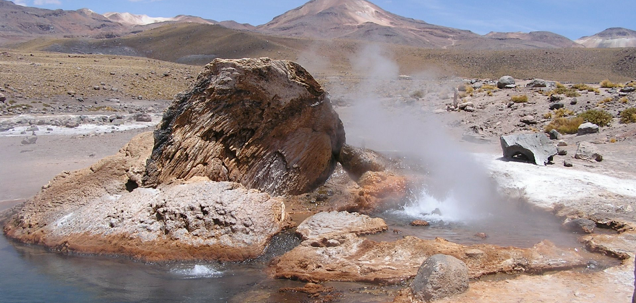Geochemistry of El Tatio Geyser Field Waters
November 16, 2009

El Tatio geyser field is a unique hydrothermal field in the Atacama Desert region of Chile. Microbial mats inhabit many of the hot springs as well as run-off from geyser features. In addition to surviving in extremely hot (up to 85 degree Celsius) waters, these microbial communities survive periods of dessication between inundation events, high UV radiation due to the high altitude and low latitude, as well as extremely high concentration of hydrothermal metals such as Arsenic and Antimony(.45 and .021 mMol respectively). Phil Bennett’s lab group has been exploring the unique geochemistry of the microbial mats and water at El Tatio. ICP-MS analysis has been used to accurately determine metal concentration in the water, and used in conjunction with HPLC analysis to determine As speciation. Microbial mats are often covered by a geyserite sinter deposit, both of which was digested and analyzed using ICP-MS to determine if either acted as a sink for Arsenic or Antimony. Results indicate partitioning of Arsenic to Iron found in the microbial mats, but significant concentrations of mobile Arsenic still in the water. Antimony partitions to the geyserite material rather than the microbial mats.
Landrum, J.T., Bennett, P.C., Engel, A.S., Alsina, M.A., Pasten, P.A., and K. Milliken., 2009. Partitioning geochemistry of arsenic and antimony, El Tatio Geyser Field, Chile. Applied Geochemistry 24, 664-676.